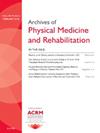Effects of Noninvasive or Minimally Invasive Neuromodulation Techniques on Neurogenic Lower Urinary Tract Dysfunction After Spinal Cord Injury: A Network Meta-analysis
IF 3.6
2区 医学
Q1 REHABILITATION
Archives of physical medicine and rehabilitation
Pub Date : 2025-06-01
DOI:10.1016/j.apmr.2024.12.016
引用次数: 0
Abstract
Objective
To assess the available evidence of noninvasive or minimally invasive neuromodulation therapies in improving urodynamic outcomes, voiding diaries, and quality of life in patients with neurogenic lower urinary tract dysfunction (NLUTD) after spinal cord injury (SCI).
Data Sources
A comprehensive search of 10 databases from inception until August 30, 2023, was conducted.
Study Selection
Randomized controlled trials (RCTs) assessing the effects of conventional treatment (CT) and CT combined with sham stimulation, transcranial magnetic stimulation (TMS), sacral nerve magnetic stimulation (SNMS), TMS+SNMS, sacral pulsed electromagnetic field therapy (SPEMFT), sacral transcutaneous electrical nerve stimulation (STENS), sacral dermatomal transcutaneous electrical nerve stimulation, bladder & STENS, transcutaneous tibial nerve stimulation (TTNS), transcutaneous electrical acupoint stimulation, pelvic floor electrical stimulation, or pelvic floor biofeedback therapy on postvoid residual volume (PVR), maximum cystometric capacity (MCC), number of voids per 24 hours (V24), mean urine volume per micturition, (MUV), maximum urinary flow rate (Qmax), maximum detrusor pressure (MDP), maximum voiding volume, number of leakages per 24 hours (L24), lower urinary tract symptoms score, and SCI-quality of life (SCI-QoL) score in patients with NLUTD after SCI were included.
Data Extraction
Two researchers independently extracted data on study characteristics and outcomes following the Preferred Reporting Items for Systematic Reviews and Meta-analysis guidelines. The Cochrane risk of bias tool (2.0) was used to assess the quality of RCTs.
Data Synthesis
Fifty-two RCTs with 2884 participants were included. CT+TMS was able to remarkably decrease PVR (mean difference [MD], −132.14; 95% confidence interval [CI], −230.97 to −33.31) and increase MUV (MD, 147.79; 95% CI, 64.51-231.06). CT+SNMS ranked high in improving V24 (MD, 2.76; 95% CI, 1.26-4.25) and reducing L24 (MD, −2.73; 95% CI, −4.46 to −1.01); CT+TMS+SNMS maximized the reduction of SCI-QoL scores (MD, −1.52; 95% CI, −2.97 to −0.25) and ranked second in both reducing PVR and improving MCC; CT+SPEMFT had a significant advantage in improving MCC (MD, 83.31; 95% CI, 39.73-126.88) and increasing Qmax (MD, 5.91; 95% CI, 2.99-8.84). Improvement in MDP was highly ranked by CT+TTNS (MD, 9.46; 95% CI, 2.15-16.76).
Conclusions
CT combined with magnetic stimulation therapy provided more benefits than its combination with electrical stimulation. TMS+SNMS seemed to be a promising noninvasive neuromodulation technique in managing NLUTD after SCI. High-quality RCTs should be conducted in the future to validate these findings.
无创或微创神经调节技术对脊髓损伤后神经源性下尿路功能障碍的影响:网络荟萃分析。
目的:评估无创或微创神经调节疗法在改善脊髓损伤(SCI)后神经源性下尿路功能障碍(NLUTD)患者尿动力学结局、排尿日记和生活质量方面的现有证据。数据来源:对10个数据库进行了全面检索,从成立到2023年8月30日。研究选择:随机对照试验(RCTs)评估常规治疗(CT)和CT联合假刺激(SS)、经颅磁刺激(TMS)、骶神经磁刺激(SNMS)、经颅磁刺激(TMS +SNMS)、骶脉冲电磁场治疗(SPEMFT)、骶经皮电神经刺激(STENS)、骶皮经皮电神经刺激(SDTENS)、膀胱及骶部经皮电神经刺激(B&STENS)、经皮胫神经刺激(TTNS)、经皮穴位电刺激(TEAS)、盆底电刺激(PFES)或盆底生物反馈治疗(PFBFBT)对空后残留体积(PVR)、最大膀胱容量(MCC)、每24小时的空数(V24)、每次排尿的平均尿量(MUV)、最大尿流率(Qmax)、最大逼尿肌压力(MDP)、最大排尿量(MVV)、每24小时漏数(L24)、纳入脊髓损伤后NLUTD患者的下尿路症状(LUTS)评分和脊髓损伤-生活质量(SCI- qol)评分。数据提取:两位研究者按照PRISMA指南独立提取研究特征和结果的数据。采用Cochrane偏倚风险工具(2.0)评估随机对照试验的质量。资料综合:纳入52项随机对照试验,共2884名受试者。CT+TMS能显著降低PVR(平均差[MD], -132.14;95%置信区间[CI], -230.97 ~ -33.31),增加MUV (MD, 147.79;95% CI, 64.51 ~ 231.06)。CT+SNMS在改善V24方面排名靠前(MD, 2.76;95% CI, 1.26 - 4.25)和降低L24 (MD, -2.73;95% CI, -4.46 ~ -1.01);CT+TMS+SNMS最大限度地降低了SCI-QoL评分(MD, -1.52;95% CI, -2.97至-0.25),在降低PVR和改善MCC方面均排名第二;CT+SPEMFT在改善MCC方面有显著优势(MD, 83.31;95% CI, 39.73 ~ 126.88)和Qmax (MD, 5.91;95% CI, 2.99 ~ 8.84);CT+TTNS对MDP的改善排名靠前(MD, 9.46;95% CI, 2.15 ~ 16.76)。结论:CT联合磁刺激治疗效果优于电刺激治疗。TMS+SNMS似乎是治疗脊髓损伤后NLUTD的一种有前途的非侵入性神经调节技术。未来应该进行高质量的随机对照试验来验证这些发现。
本文章由计算机程序翻译,如有差异,请以英文原文为准。
求助全文
约1分钟内获得全文
求助全文
来源期刊
CiteScore
6.20
自引率
4.70%
发文量
495
审稿时长
38 days
期刊介绍:
The Archives of Physical Medicine and Rehabilitation publishes original, peer-reviewed research and clinical reports on important trends and developments in physical medicine and rehabilitation and related fields. This international journal brings researchers and clinicians authoritative information on the therapeutic utilization of physical, behavioral and pharmaceutical agents in providing comprehensive care for individuals with chronic illness and disabilities.
Archives began publication in 1920, publishes monthly, and is the official journal of the American Congress of Rehabilitation Medicine. Its papers are cited more often than any other rehabilitation journal.

 求助内容:
求助内容: 应助结果提醒方式:
应助结果提醒方式:


